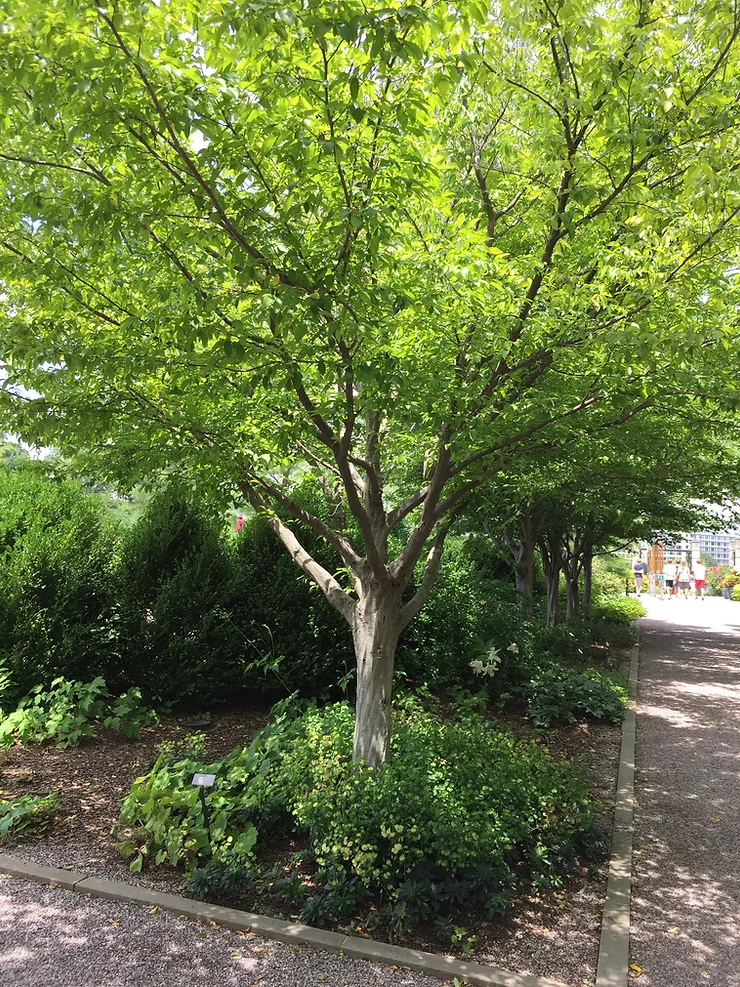Good Tree Planting and Maintenance
Good tree planting and maintenance starts with selecting the right species for your site.
It is important that the selected species is appropriate for the climate and for the sun and moisture conditions, but there also needs to be room for the species. This means considering both what is above ground and below ground, soil volume is important. The root area should be about 1/3 less than the mature canopy’s extent. Trees can share space; plant them together and they will support one another.
Once you have selected a species, it is important to buy a good quality tree to plant. Research consistently points to using smaller stock when planting for the best results. Trees of 1.5 inch caliper or less (the diameter at six inches above the soil) establish faster, grow better and need less after-planting care than larger trees.
Besides looking for smaller trees, look for good roots. The root flare, where the tree stops being trunk and becomes roots, should be at or very near the top of the root ball. If it is too deep, the root system will already be irrevocably compromised. Pull the tree from the container and look at the roots. They should be brown and no more than 1/8 inch thick.
Before planting, slice off the outer 1.5 inches of the sides and bottom of the root ball. (https://hort.ifas.ufl.edu/woody/circle-removing.shtml)
Dig a hole 3 times wider than and the same depth as the root ball.
Score the sides of the hole to roughen it up, and deepen the outer edge of the bottom to make a central pedestal.
Set the tree upright on the pedestal and refill the hole with the UNAMENDED soil from the hole.
Water well.
NOTHING goes in the hole but the tree, water, and the soil removed. Again, DO NOT fertilize newly planted trees and shrubs.
Mulch with 4 inches of green wood chips or 2 inches of wood (not bark) mulch. Prune ONLY dead and broken branches.
Use 1 gallon of water per inch caliper to water every day for 4 weeks then every other day until established – usually 1 year per inch caliper.
See www.treesaregood.org for more information on tree care and planting.
Native trees:
Shade and cool our communities
Increase home values
Sequester carbon
Support birds, butterflies and other wildlife
Reduce air conditioning costs
Capture stormwater
Protect our water supply and the Chesapeake Bay
The spaces most in need of trees are on private property, including residential lawns, community common lands, faith community landscapes and business properties. We need residents and business owners to help increase the Southern Piedmont’s native tree canopy!
CHICKADEES, CATERPILLARS, AND A MAJESTIC OAK, OH MY!
ENJOY THIS NEW ANIMATED VIDEO FROM PLANT VIRGINIA NATIVES!
Help Trees Thrive: Tear Up Some Turf
It’s fairly common in residential neighborhoods to see trees surrounded by grass or by small mulch beds, often heaped high like a volcano. But did you know that your trees would be healthier and grow faster if you replaced that turf and mulch volcanos with a 2-4” deep ring of mulch that extends out to the tree’s drip line or even beyond? Let’s look at why this is…
Continue reading this article by the Plant NOVA Natives campaign.
Trees and Fertilizers
Never add fertilizer unless you have a soil test that indicates it is needed.
Trees monitor their environments and internal chemical balances to determine how and where to expend energy. For newly planted trees, three critical elements are carbon (C), nitrogen (N), and phosphorous (P).
The C/N ratio: Tree C, in the form of sugars, comes from photosynthesis and is a measure of canopy size; N comes from the soil and is a measure of root system size. When C/N is low, the tree perceives the canopy to be small relative to the roots and directs energy to canopy growth and vice versa. Adding N to soil of newly planted trees can lower C/N and cause the tree to grow canopy when it needs to grow roots.
High soil P interferes with iron uptake and chlorophyll creation resulting in chlorosis and lower energy production. High soil P also reduces mycorrhizae formation, reducing the availability of water and nutrients to the tree when it is most needed.
DO NOT fertilize newly planted trees and shrubs.
Tree Planting & Care Resources
Guidance on planting trees
Virginia Dept of ForestryGuidance on pruning and caring for individual trees
Virginia Dept of ForestryTrees Virginia - Virginia’s Urban Forest Council
Waynesboro Tree Webinar presentations are available on the Trees Virginia YouTube channelVirginia Soil and Water Conservation Districts (check out the native seedlings sales)
Regional Tree Stewards (for a list, visit https://treesvirginia.org/outreach/tree-stewards)
How to Plant a Tree Video - and Tree Planting Guide - Charlottesville Area Tree Stewards and Tree Planting and Maintenance - Fredericksburg Area Tree StewardsVirginia Master Naturalist chapters
Virginia Master Gardener chapters
Tree Care (Plant NOVA Natives), including a great downloadable Tree Basics guide, which is available in Spanish, Chinees, Arabic, Korean, Vietnamese
Also, check-out this great webpage on tree planting from our Mid-Atlantic partner, Blue Water Baltimore.
Visit the National Arbor Foundation website for more information about Arbor Day and other programs!




